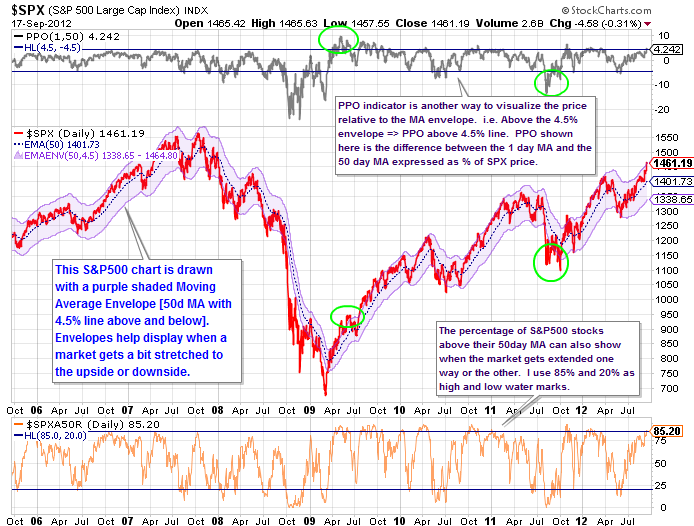 By Brad Tompkins
By Brad Tompkins
There has been plenty of media coverage recently related to whether the stock market is overbought or not. It is interesting and certainly entertaining. But is it relevant information we need to know as traders? Let’s frame the discussion with two points:
· How do you measure overbought or oversold?
· What is the appropriate trading reaction?
The chart below shows the S&P 500 index with a couple common ways to quantify how stretched the market may be. The first is a simple moving average envelope. We see today that the large cap index is roughly 4.5% above its 50 day moving average. We also notice that over the last 7 years it doesn’t spend much time outside of the 4.5% envelope and many important pivot price levels happen to coincide with turns near the envelope edges. The chart also includes an indicator for the percentage of S&P 500 stocks above their 50 day moving average. At extremes (above 85% or below 20%) we recognize another correlation to significant price turns.
So in some regard we can quantify overbought or oversold and in fact recognize today’s market near a distended level by both measures. What is a trader’s appropriate response? First things first, don’t make the mistake thinking markets have to revert immediately once they get extended. If you spend a little more time looking at the chart, you’ll begin to see many instances where the index became overbought or oversold and then it continued for weeks getting even more overbought or oversold. For every significant turn that happened shortly after those indicators hit our extreme level alerts, there are several examples – Sept ’06, Sept ’08, & Sept ’10 – where you would have gotten run over if you tried to take a position prematurely picking tops and bottoms. Side note: it is even more dangerous with individual stocks.
To be clear, it is helpful to be aware of extremes. But instead of loading up for a sharp reversal, just use it as a warning reminder to manage portfolio risk. Maybe tighten stops or take some profits or add some hedges as need be. It might also be a caution flag to reduce new position sizes. If your trading plan is sound, you shouldn’t have to make many adjustments just because the market is stretched. Let the price action unfold to bring you in and take you out of positions like it does in all other circumstances.
Markets can persist in their extended state for a long time. Let the media pundits battle trying to be heroes picking the tops and bottoms. For the rest of us, note the condition and stick to the trading plan. Continue executing as you normally would. In reality, we get paid by trading well, not by winning the “most overbought” debate.
———————————————————
Twitter: @BBTompkins and @seeitmarket Facebook: See It Market
Position in SPX e-mini futures at the time of publication.
Any opinions expressed herein are solely those of the author, and do not in any way represent the views or opinions of any other person or entity.









